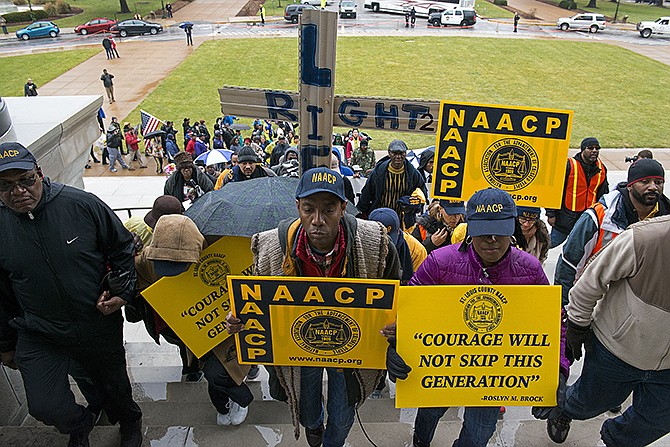Protesters entered the Missouri Capitol on Friday wet, cold and tired from the last eight miles of their 130-mile, six-day journey from Ferguson to Jefferson City.
But the soaked clothes and sore feet did not dampen their spirits as they entered the building and shouted, "Never quit" and "We are the warriors, the justice warriors."
The march, "Journey for Justice: Ferguson to Jefferson City," started Saturday in response to the St. Louis County grand jury's decision not to indict former Ferguson police officer Darren Wilson for killing Michael Brown Jr.
During the six days, the marchers walked around 20 miles every day in shifts. Some would fall back to support buses that slowly followed the group, while others pressed on. Marchers spent their nights in host churches, and others stayed in hotels. Also, many people joined the group after catching up to them or as they walked through their town. People came from as far as Michigan, Tennessee, Massachusetts and Canada to join the journey.
For the last leg of the journey Friday, around 100 marchers left Quinn Chapel at 8 a.m. on two buses to continue the march from the endpoint of the previous day.
"A violent act set this whole tragedy into motion, and there has been violence since then," Cornell William Brooks, president and chief executive officer of NAACP, said as the day began Friday. "We are here to make clear that not only is nonviolence morally preferable, it is more effective. ...
"We are doing that predicated on the Selma-to-Montgomery march of almost 50 years ago, drawing upon the deep civil rights history and the important moral heritage of that march, both of which teach us that when Americans are challenged, they can draw upon their deepest moral and constitutional values, rise to the occasion and overcome an injustice."
Around 10 a.m. Friday, the marchers entered the city limits on U.S. 50 and marched toward Monroe Street. They chanted and sang as they walked up Monroe to Capitol Avenue and toward the Governor's Mansion and Capitol. As they passed the Mansion, where they had initially planned to congregate, they continued on to the Capitol building.
Approximately 40 other protesters joined them at the Capitol Rotunda for speeches from Brooks, as well as Brown's parents and others.
The significance of the final steps of the journey struck many of the marchers.
"I don't know how I am going to return to my normal life," said Andrew McFadyen-Ketchum, a poet who volunteered to help independently and has been with the protesters since Ferguson. "It is hard to believe; I am just so proud that we did it. ...
"President Brooks and his people were such an inspiration, and I have just had such a great time doing as I was instructed," he said. "It has been a real, real, real privilege and a wonderful experience."
He sat down in a secluded hallway outside of the Rotunda and talked about ending the journey.
Tears began to fall from his eyes, and his voice cracked. He said he appreciated that no one tried to hurt the marchers, except for their feelings, such as the counter-protest in Rosebud and the occasional foul-mouthed motorist.
In the background, the audience cheered as the Rev. Cassandra Gould of the Quinn Chapel Church finished speaking.
Kendall Wright of Palmyra said he was at a loss for words. He is a leader of Lincoln University Pride and the LU chemistry club. He began marching Thursday.
"Our voice is being heard," Wright said. "We are showing this country through peaceful acts that our voices can be heard."
Phil Dage, a social and political activist from Detroit, said it felt "amazing" to be at the march's destination and he was "very invigorated." He marched with the group for at least the past three days.
As the marchers settled into the Rotunda, the guest speakers spoke about race and criminal justice. Brooks took to the stage and passionately explained why he marched. In his explanation, Brooks said he marched to seek justice for Brown's family and "nothing less than a fundamental systemic reform of policing in this country."
Even though the walk had ended, the journey will continue, Brooks said.
"We will march until hell freezes over, and when it does, we will march on the ice," he said.
Above Brooks was a circle of fourth-graders, their chaperones and government employees who spent a few minutes witnessing speeches from NAACP leaders and the chants of audience members.
One of the chaperones, Mary McDevitt, said it was "history in the making" and a chance for the children to see "democracy in action."
The ceremony ended with attendees in the Rotunda joining hands in closing prayer. As they were praying, two buses drove down Capitol Avenue, preparing to start the journey back to Ferguson.

